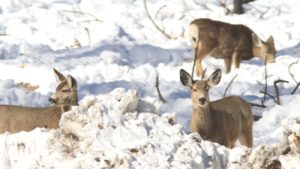 Humans aren’t the only ones who can find it a bit of a struggle when extremely frigid weather or unusually deep snow hits Idaho. Our state’s wildlife — specifically deer, elk and pronghorn — has adapted over thousands of years to withstand fairly harsh winter conditions, but sometimes conditions are so harsh it leads to significant winter die-offs. Idaho Fish and Game’s emergency big game feeding policy states that wildlife should be self-sustaining and reliant on natural habitat, not supplementally fed every winter, but there are some exceptions.
Humans aren’t the only ones who can find it a bit of a struggle when extremely frigid weather or unusually deep snow hits Idaho. Our state’s wildlife — specifically deer, elk and pronghorn — has adapted over thousands of years to withstand fairly harsh winter conditions, but sometimes conditions are so harsh it leads to significant winter die-offs. Idaho Fish and Game’s emergency big game feeding policy states that wildlife should be self-sustaining and reliant on natural habitat, not supplementally fed every winter, but there are some exceptions.
The Department is authorized to feed big game if the following conditions exist.
When extreme weather threatens massive die-offs, Fish and Game has feed stockpiled so department staff can react. But even during normal winters, some wildlife mortality is expected, and the department’s policy is that big game populations should generally be maintained under natural conditions and with naturally available forage.
Fish and Game maintains regional winter feeding advisory committees in four of the seven regions. These advisory committees are made up of citizen volunteers who make recommendations to Fish and Game about whether emergency feeding should be considered.
If it looks as though weather conditions will significantly affect herd survival, Fish and Game consults with the regional advisory committees, and they discuss winter range conditions, such as snow crusting and temperatures. Deep, crusted snow hinders an animal’s ability to forage, and extended periods of freezing temperatures increasingly deplete an animal’s energy reserves as they seek out food and avoid predators.
Fish and Game will sometimes use alternative food sources to lure deer and elk away from feeding on a landowner’s stored agricultural crops, such as hay, or to keep deer and elk out of livestock operations where they compete with livestock for feed and potentially spread disease.
Same goes for big game animals posing a threat to human safety. To entice big game animals away from major highways and roadways, Fish and Game wildlife managers will sometimes use feeding sites to keep animals from repeatedly crossing roadways.
Winter is the most vulnerable time for many big game animals, especially young and old animals. It’s also when animals are often most visible because they’re congregating at lower elevations in open country in many parts of the state.
People can help wintering big game by leaving them undisturbed. Plan your winter outings away from winter range. Big game animals have limited reserves of energy that’s stored as fat, and when it’s waning or gone, they’re more likely to succumb to winter kill, which is typically malnutrition, disease, predation or a combination of those.
Fish and Game staff are ready, able, and willing to act in emergency situations. They also know not every animal will survive each winter, but the fittest will survive and pass those traits along to their offspring and keep herds healthy into the future.
To learn more, see the Big Game Winter Feeding webpage.
